1
3 Structured Program Development in C
2007 Pearson Education, Inc. All rights reserved.
2
Let’s all move one place on.
—Lewis Carroll
The wheel is come full circle.
—William Shakespeare
How many apples fell on Newton’s head before he took the hint! —Robert Frost
All the evolution we know of proceeds from the vague to the definite.
—Charles Sanders Peirce
2007 Pearson Education, Inc. All rights reserved.
3
OBJECTIVES
In this chapter you will learn: Basic problem-solving techniques. To develop algorithms through the process of
top-down, stepwise refinement.
To use the if selection statement and if...else
selection statement to select actions.
To use the while repetition statement to execute
statements in a program repeatedly.
Counter-controlled repetition and sentinel-controlled
repetition.
Structured programming. The increment, decrement and assignment operators.
2007 Pearson Education, Inc. All rights reserved.
4
Introduction
3.1
Algorithms
3.2
Pseudocode
3.3
3.4
Control Structures
3.5
The if Selection Statement
3.6
The if...else Selection Statement
3.7
The while Repetition Statement
2007 Pearson Education, Inc. All rights reserved.
5
3.8
Formulating Algorithms: Case Study 1 (Counter-Controlled Repetition)
3.9
Formulating Algorithms with Top-Down, Stepwise Refinement: Case Study 2 (Sentinel-Controlled Repetition)
3.10 Formulating Algorithms with Top-Down, Stepwise
Refinement: Case Study 3 (Nested Control Structures)
3.11 Assignment Operators
3.12
Increment and Decrement Operators
2007 Pearson Education, Inc. All rights reserved.
6
3.1 Introduction
Before writing a program:
– Have a thorough understanding of the problem – Carefully plan an approach for solving it
While writing a program:
– Know what “building blocks” are available – Use good programming principles
2007 Pearson Education, Inc. All rights reserved.
7
3.2 Algorithms
Computing problems
– All can be solved by executing a series of actions in a
specific order
Algorithm: procedure in terms of
– Actions to be executed – The order in which these actions are to be executed
Program control
– Specify order in which statements are to be executed
2007 Pearson Education, Inc. All rights reserved.
8
3.3 Pseudocode
Pseudocode
– Artificial, informal language that helps us develop
algorithms
– Similar to everyday English – Not actually executed on computers – Helps us “think out” a program before writing it - Easy to convert into a corresponding C++ program - Consists only of executable statements
2007 Pearson Education, Inc. All rights reserved.
9
3.4 Control Structures
Sequential execution
– Statements executed one after the other in the order written
Transfer of control
– When the next statement executed is not the next one in sequence – Overuse of goto statements led to many problems
Bohm and Jacopini
– All programs written in terms of 3 control structures
- Sequence structures: Built into C. Programs executed sequentially
by default
- Selection structures: C has three types: if, if…else, and switch - Repetition structures: C has three types: while, do…while and for
2007 Pearson Education, Inc. All rights reserved.
10
Fig. 3.1 | Flowcharting C’s sequence structure.
2007 Pearson Education, Inc. All rights reserved.
11
3.4 Control Structures
Flowchart
– Graphical representation of an algorithm – Drawn using certain special-purpose symbols connected by
arrows called flowlines
– Rectangle symbol (action symbol): - Indicates any type of action
– Oval symbol:
- Indicates the beginning or end of a program or a section of code
Single-entry/single-exit control structures
– Connect exit point of one control structure to entry point of the
next (control-structure stacking)
– Makes programs easy to build
2007 Pearson Education, Inc. All rights reserved.
12
3.5 The if selection statement
Selection structure:
– Used to choose among alternative courses of action – Pseudocode:
If student’s grade is greater than or equal to 60
Print “Passed”
If condition true
– Print statement executed and program goes on to next
statement
– If false, print statement is ignored and the program goes
onto the next statement
– Indenting makes programs easier to read
- C ignores whitespace characters
2007 Pearson Education, Inc. All rights reserved.
13
Good Programming Practice 3.1
Consistently applying responsible indentation conventions greatly improves program readability. We suggest a fixed-size tab of about 1/4 inch or three blanks per indent. In this book, we use three blanks per indent.
2007 Pearson Education, Inc. All rights reserved.
14
Good Programming Practice 3.2
Pseudocode is often used to “think out” a program during the program design process. Then the pseudocode program is converted to C.
2007 Pearson Education, Inc. All rights reserved.
15
3.5 The if selection statement
Pseudocode statement in C: if ( grade >= 60 )
printf( "Passed\n" );
– C code corresponds closely to the pseudocode
Diamond symbol (decision symbol)
– Indicates decision is to be made – Contains an expression that can be true or false – Test the condition, follow appropriate path
2007 Pearson Education, Inc. All rights reserved.
16
Fig. 3.2 | Flowcharting the single-selection if statement.
2007 Pearson Education, Inc. All rights reserved.
17
3.6 The if…else selection statement
if
– Only performs an action if the condition is true
if…else
– Specifies an action to be performed both when the
condition is true and when it is false
Psuedocode:
If student’s grade is greater than or equal to 60
Print “Passed”
else
Print “Failed”
– Note spacing/indentation conventions
2007 Pearson Education, Inc. All rights reserved.
18
Good Programming Practice 3.3
Indent both body statements of an if...else statement.
2007 Pearson Education, Inc. All rights reserved.
19
Good Programming Practice 3.4
If there are several levels of indentation, each level should be indented the same additional amount of space.
2007 Pearson Education, Inc. All rights reserved.
20
3.6 The if…else selection statement
C code:
if ( grade >= 60 ) printf( "Passed\n"); else printf( "Failed\n"); Ternary conditional operator (?:)
– Takes three arguments (condition, value if true, value if false) – Our pseudocode could be written:
printf( "%s\n", grade >= 60 ? "Passed" : "Failed" );
– Or it could have been written:
grade >= 60 ? printf( “Passed\n” ) : printf( “Failed\n”
);
2007 Pearson Education, Inc. All rights reserved.
21
Fig. 3.3 | Flowcharting the double-selection if...else statement.
2007 Pearson Education, Inc. All rights reserved.
22
3.6 The if…else selection statement
Nested if…else statements
– Test for multiple cases by placing if…else selection
statements inside if…else selection statement – Once condition is met, rest of statements skipped – Deep indentation usually not used in practice
2007 Pearson Education, Inc. All rights reserved.
23
3.6 The if…else selection statement
– Pseudocode for a nested if…else statement If student’s grade is greater than or equal to 90 Print “A” else If student’s grade is greater than or equal to 80 Print “B” else If student’s grade is greater than or equal to 70 Print “C” else If student’s grade is greater than or equal to 60 Print “D” else Print “F”
2007 Pearson Education, Inc. All rights reserved.
24
3.6 The if…else selection statement
Compound statement:
– Set of statements within a pair of braces – Example:
if ( grade >= 60 ) printf( "Passed.\n" ); else { printf( "Failed.\n" ); printf( "You must take this course
again.\n" ); }
– Without the braces, the statement
printf( "You must take this course
again.\n" ); would be executed automatically
2007 Pearson Education, Inc. All rights reserved.
25
Software Engineering Observation 3.1
A compound statement can be placed anywhere in a program that a single statement can be placed.
2007 Pearson Education, Inc. All rights reserved.
26
Common Programming Error 3.1
Forgetting one or both of the braces that delimit a compound statement.
2007 Pearson Education, Inc. All rights reserved.
27
3.6 The if…else selection statement
Block:
– Compound statements with declarations
Syntax errors
– Caught by compiler
Logic errors:
– Have their effect at execution time – Non-fatal: program runs, but has incorrect output – Fatal: program exits prematurely
2007 Pearson Education, Inc. All rights reserved.
28
Common Programming Error 3.2
Placing a semicolon after the condition in an if statement as in if ( grade >= 60 ); leads to a logic error in single-selection if statements and a syntax error in double-selection if statements.
2007 Pearson Education, Inc. All rights reserved.
29
Error-Prevention Tip 3.1
Typing the beginning and ending braces of compound statements before typing the individual statements within the braces helps avoid omitting one or both of the braces, preventing syntax errors and logic errors (where both braces are indeed required).
2007 Pearson Education, Inc. All rights reserved.
30
Software Engineering Observation 3.2
Just as a compound statement can be placed anywhere a single statement can be placed, it is also possible to have no statement at all, i.e., the empty statement. The empty statement is represented by placing a semicolon (;) where a statement would normally be.
2007 Pearson Education, Inc. All rights reserved.
31
3.7 The while repetition statement
Repetition structure
– Programmer specifies an action to be repeated while some
condition remains true
– Pseudocode:
While there are more items on my shopping list Purchase next item and cross it off my list
– while loop repeated until condition becomes false – Example:
int product = 2; while ( product <= 1000 )
product = 2 * product;
2007 Pearson Education, Inc. All rights reserved.
32
Common Programming Error 3.3
Not providing the body of a while statement with an action that eventually causes the condition in the while to become false. Normally, such a repetition structure will never terminate—an error called an “infinite loop.”
2007 Pearson Education, Inc. All rights reserved.
33
Common Programming Error 3.4
Spelling the keyword while with an uppercase W as in While (remember that C is a case-sensitive language). All of C’s reserved keywords such as while, if and else contain only lowercase letters.
2007 Pearson Education, Inc. All rights reserved.
34
Fig. 3.4 | Flowcharting the while repetition statement.
2007 Pearson Education, Inc. All rights reserved.
35
3.8 Counter-Controlled Repetition
Counter-controlled repetition
– Loop repeated until counter reaches a certain value – Definite repetition: number of repetitions is known – Example: A class of ten students took a quiz. The grades
(integers in the range 0 to 100) for this quiz are available to you. Determine the class average on the quiz.
2007 Pearson Education, Inc. All rights reserved.
36
Fig. 3.5 | Pseudocode algorithm that uses counter-controlled repetition to solve the class average problem.
2007 Pearson Education, Inc. All rights reserved.
Outline
fig03_06.c
(1 of 2 )
Counter to control while loop
Initialize counter to 1
37
while loop iterates as long as
counter <= 10
Increment the counter
2007 Pearson Education, Inc. All rights reserved.
Outline
Calculate the average
fig03_06.c
(2 of 2 )
38
2007 Pearson Education, Inc. All rights reserved.
39
Common Programming Error 3.5
If a counter or total is not initialized, the results of your program will probably be incorrect. This is an example of a logic error.
2007 Pearson Education, Inc. All rights reserved.
40
Error-Prevention Tip 3.2
Initialize all counters and totals.
2007 Pearson Education, Inc. All rights reserved.
41
3.9 Formulating Algorithms with Top- Down, Stepwise Refinement
Problem becomes:
Develop a class-averaging program that will process an
arbitrary number of grades each time the program is run.
– Unknown number of students – How will the program know to end?
Use sentinel value
– Also called signal value, dummy value, or flag value – Indicates “end of data entry.” – Loop ends when user inputs the sentinel value – Sentinel value chosen so it cannot be confused with a
regular input (such as -1 in this case)
2007 Pearson Education, Inc. All rights reserved.
42
Common Programming Error 3.6
Choosing a sentinel value that is also a legitimate data value.
2007 Pearson Education, Inc. All rights reserved.
43
3.9 Formulating Algorithms with Top- Down, Stepwise Refinement
Top-down, stepwise refinement
– Begin with a pseudocode representation of the top:
Determine the class average for the quiz
– Divide top into smaller tasks and list them in order:
Initialize variables
Input, sum and count the quiz grades Calculate and print the class average
Many programs have three phases:
– Initialization: initializes the program variables – Processing: inputs data values and adjusts program
variables accordingly
– Termination: calculates and prints the final results
2007 Pearson Education, Inc. All rights reserved.
44
Software Engineering Observation 3.3
Each refinement, as well as the top itself, is a complete specification of the algorithm; only the level of detail varies.
2007 Pearson Education, Inc. All rights reserved.
45
3.9 Formulating Algorithms with Top- Down, Stepwise Refinement
Refine the initialization phase from Initialize
variables to:
Initialize total to zero
Initialize counter to zero
Refine Input, sum and count the quiz grades to
Input the first grade (possibly the sentinel)
While the user has not as yet entered the sentinel Add this grade into the running total Add one to the grade counter Input the next grade (possibly the sentinel)
2007 Pearson Education, Inc. All rights reserved.
46
3.9 Formulating Algorithms with Top- Down, Stepwise Refinement
Refine Calculate and print the class average to
If the counter is not equal to zero
Set the average to the total divided by the counter Print the average else Print “No grades were entered”
2007 Pearson Education, Inc. All rights reserved.
47
Common Programming Error 3.7
An attempt to divide by zero causes a fatal error.
2007 Pearson Education, Inc. All rights reserved.
48
Fig. 3.7 | Pseudocode algorithm that uses sentinel-controlled repetition to solve the class average problem.
2007 Pearson Education, Inc. All rights reserved.
49
Good Programming Practice 3.5
When performing division by an expression whose value could be zero, explicitly test for this case and handle it appropriately in your program (such as printing an error message) rather than allowing the fatal error to occur.
2007 Pearson Education, Inc. All rights reserved.
50
Software Engineering Observation 3.4
Many programs can be divided logically into three phases: an initialization phase that initializes the program variables; a processing phase that inputs data values and adjusts program variables accordingly; and a termination phase that calculates and prints the final results.
2007 Pearson Education, Inc. All rights reserved.
51
Software Engineering Observation 3.5
You terminate the top-down, stepwise refinement process when the pseudocode algorithm is specified in sufficient detail for you to be able to convert the pseudocode to C. Implementing the C program is then normally straightforward.
2007 Pearson Education, Inc. All rights reserved.
Outline
fig03_08.c
(1 of 3 )
52
float type indicates
variable can be a non- integer
2007 Pearson Education, Inc. All rights reserved.
Outline
53
while loop repeats until user enters
a value of -1
fig03_08.c
(2 of 3 )
Ensures the user entered at least one grade
Converts total to float type
Prints result with 2 digits after decimal point
2007 Pearson Education, Inc. All rights reserved.
Outline
fig03_08.c
(3 of 3 )
54
2007 Pearson Education, Inc. All rights reserved.
55
Good Programming Practice 3.6
In a sentinel-controlled loop, the prompts requesting data entry should explicitly remind the user what the sentinel value is.
2007 Pearson Education, Inc. All rights reserved.
56
Common Programming Error 3.8
Using precision in a conversion specification in the format control string of a scanf statement is wrong. Precisions are used only in printf conversion specifications.
2007 Pearson Education, Inc. All rights reserved.
57
Common Programming Error 3.9
Using floating-point numbers in a manner that assumes they are represented precisely can lead to incorrect results. Floating-point numbers are represented only approximately by most computers.
2007 Pearson Education, Inc. All rights reserved.
58
Error-Prevention Tip 3.3
Do not compare floating-point values for equality.
2007 Pearson Education, Inc. All rights reserved.
59
3.10 Nested Control Structures
Problem
– A college has a list of test results (1 = pass, 2 = fail) for 10
students
– Write a program that analyzes the results
- If more than 8 students pass, print "Raise Tuition"
Notice that
– The program must process 10 test results - Counter-controlled loop will be used
– Two counters can be used
- One for number of passes, one for number of fails
– Each test result is a number—either a 1 or a 2 - If the number is not a 1, we assume that it is a 2
2007 Pearson Education, Inc. All rights reserved.
60
3.10 Nested Control Structures
Top level outline
Analyze exam results and decide if tuition should be raised
First Refinement Initialize variables Input the ten quiz grades and count passes and failures Print a summary of the exam results and decide if tuition should
be raised
Refine Initialize variables to Initialize passes to zero Initialize failures to zero Initialize student counter to one
2007 Pearson Education, Inc. All rights reserved.
61
3.10 Nested Control Structures
Refine Input the ten quiz grades and count passes and
failures to
While student counter is less than or equal to ten
Input the next exam result
If the student passed Add one to passes else Add one to failures
Add one to student counter
Refine Print a summary of the exam results and decide if
tuition should be raised to Print the number of passes Print the number of failures If more than eight students passed
Print “Raise tuition”
2007 Pearson Education, Inc. All rights reserved.
62
Fig. 3.9 | Pseudocode for examination results problem.
2007 Pearson Education, Inc. All rights reserved.
Outline
fig03_10.c
(1 of 3 )
63
while loop continues until 10 students have been processed
if and else statements are nested
inside while loop
2007 Pearson Education, Inc. All rights reserved.
Outline
fig03_10.c
(2 of 3 )
64
2007 Pearson Education, Inc. All rights reserved.
Outline
fig03_10.c
(3 of 3 )
65
2007 Pearson Education, Inc. All rights reserved.
66
Performance Tip 3.1
Initializing variables when they are defined can help reduce a program’s execution time.
2007 Pearson Education, Inc. All rights reserved.
67
Performance Tip 3.2
Many of the performance tips we mention in this text result in nominal improvements, so the reader may be tempted to ignore them. Note that the cumulative effect of all these performance enhancements can make a program perform significantly faster. Also, significant improvement is realized when a supposedly nominal improvement is placed in a loop that may repeat a large number of times.
2007 Pearson Education, Inc. All rights reserved.
68
Software Engineering Observation 3.6
Experience has shown that the most difficult part of solving a problem on a computer is developing the algorithm for the solution. Once a correct algorithm has been specified, the process of producing a working C program is normally straightforward.
2007 Pearson Education, Inc. All rights reserved.
69
Software Engineering Observation 3.7
Many programmers write programs without ever using program development tools such as pseudocode. They feel that their ultimate goal is to solve the problem on a computer and that writing pseudocode merely delays the production of final outputs.
2007 Pearson Education, Inc. All rights reserved.
70
3.11 Assignment Operators
Assignment operators abbreviate assignment expressions
c = c + 3;
can be abbreviated as c += 3; using the addition assignment
operator
Statements of the form
variable = variable operator expression;
can be rewritten as
variable operator= expression;
Examples of other assignment operators:
d -= 4 (d = d - 4) e *= 5 (e = e * 5) f /= 3 (f = f / 3) g %= 9 (g = g % 9)
2007 Pearson Education, Inc. All rights reserved.
71
Fig. 3.11 | Arithmetic assignment operators.
2007 Pearson Education, Inc. All rights reserved.
72
3.12 Increment and Decrement Operators
Increment operator (++)
– Can be used instead of c+=1
Decrement operator (--)
– Can be used instead of c-=1
Preincrement
– Operator is used before the variable (++c or --c) – Variable is changed before the expression it is in is evaluated
Postincrement
– Operator is used after the variable (c++ or c--) – Expression executes before the variable is changed
2007 Pearson Education, Inc. All rights reserved.
73
3.12 Increment and Decrement Operators
If c equals 5, then
printf( "%d", ++c );
– Prints 6
printf( "%d", c++ );
– Prints 5 – In either case, c now has the value of 6
When variable not in an expression
– Preincrementing and postincrementing have the same effect
++c; printf( “%d”, c ); – Has the same effect as
c++; printf( “%d”, c );
2007 Pearson Education, Inc. All rights reserved.
74
Fig. 3.12 | Increment and decrement operators.
2007 Pearson Education, Inc. All rights reserved.
Outline
fig03_13.c
75
c is printed, then incremented
c is incremented, then printed
2007 Pearson Education, Inc. All rights reserved.
76
Good Programming Practice 3.7
Unary operators should be placed directly next to their operands with no intervening spaces.
2007 Pearson Education, Inc. All rights reserved.
77
Common Programming Error 3.10
Attempting to use the increment or decrement operator on an expression other than a simple variable name is a syntax error, e.g., writing ++(x + 1).
2007 Pearson Education, Inc. All rights reserved.
78
Error-Prevention Tip 3.4
C generally does not specify the order in which an operator’s operands will be evaluated (although we will see exceptions to this for a few operators in Chapter 4). Therefore you should avoid using statements with increment or decrement operators in which a particular variable being incremented or decremented appears more than once.
2007 Pearson Education, Inc. All rights reserved.
79
Fig. 3.14 | Precedence of the operators encountered so far in the text.
2007 Pearson Education, Inc. All rights reserved.


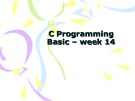
![Bài giảng Lập trình C cơ bản: Tuần 13 [Mới nhất]](https://cdn.tailieu.vn/images/document/thumbnail/2024/20240503/codabach1016/135x160/1511714732838.jpg)
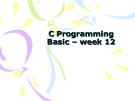
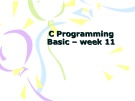
![Bài giảng Lập trình C cơ bản: Tuần 10 [Mới Nhất]](https://cdn.tailieu.vn/images/document/thumbnail/2024/20240503/codabach1016/135x160/9751714732844.jpg)
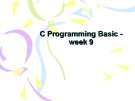
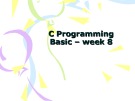
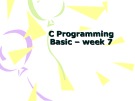
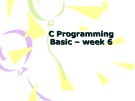
![Tài liệu ôn tập môn Lập trình web 1 [mới nhất/chuẩn nhất]](https://cdn.tailieu.vn/images/document/thumbnail/2025/20251208/hongqua8@gmail.com/135x160/8251765185573.jpg)









![Hệ thống quản lý cửa hàng bán thức ăn nhanh: Bài tập lớn [chuẩn nhất]](https://cdn.tailieu.vn/images/document/thumbnail/2025/20251112/nguyenhuan6724@gmail.com/135x160/54361762936114.jpg)
![Bộ câu hỏi trắc nghiệm Nhập môn Công nghệ phần mềm [mới nhất]](https://cdn.tailieu.vn/images/document/thumbnail/2025/20251111/nguyenhoangkhang07207@gmail.com/135x160/20831762916734.jpg)



